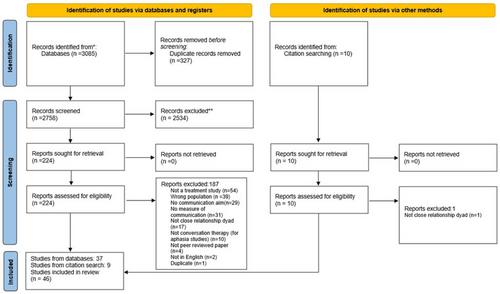Measuring successful conversations in couples with and without aphasia: A scoping review
Abstract
Background
Aphasia impacts communication and relationships. While counselling is increasingly recognised as a component of the speech-language therapy role, the success of conversation partner training is typically measured in terms of communication alone. This scoping review aimed to describe how successful conversation is currently measured with couples—with and without aphasia, to inform the development of an ecologically valid measure for couples with aphasia.
Methods and Procedures
The scoping review was reported in alignment with the Preferred Reporting Items for Systematic Reviews and Meta-Analysis Extensions for Scoping Reviews (PRISMA-SCR). MEDLINE, EMBASE, CINAHL and PsycINFO databases were searched for conversation treatment studies for couples with and without aphasia. Patient-reported outcome measures (PROMs) were extracted from included studies and screened against the three-tier model of situated language to shortlist those that measure everyday communication. Items within shortlisted PROMs were further described using the refined International Classification of Functioning, Disability and Health linking rules.
Results
Following screening and full-text review, 46 studies were included, consisting of 24 studies conducted with couples with aphasia and 22 studies conducted with couples without aphasia. For couples with aphasia, 13 PROMs were identified that measured everyday communication. Of these, 23% were dyadic (i.e., measured from the perspectives of both members of the couple); however, they usually only appraised the communication behaviours of the person with aphasia. For couples without aphasia, eight PROMs were identified that measured everyday communication; all were dyadic and measured both attitudes and communication behaviours of both partners.
Conclusion
Conversation relies on the interaction of two people, and success in conversation is best rated by those having the conversation. The use of PROMs is recommended as part of person and relationship-centred practice; however, there is currently no validated PROM for conversation in aphasia that considers the perspectives and behaviours of both the person with aphasia and their communication partner. The PROM items identified in this study will form the basis of future research to develop a PROM for couples' conversations in aphasia.
WHAT THIS PAPER ADDS
What is already known on the subject
- Communication partner training (CPT) for couples, where one person has aphasia, can improve conversation skills and enhance relationships. Clinician-rated measures, such as conversation analysis, have been used to measure the outcomes of CPT. However, there is a lack of person-centred or self-rated outcome measurement instruments. that is, patient-reported outcome measures (PROMs) for couples' conversations in aphasia.
What this paper adds to existing knowledge
- We have identified outcome measurement instruments used in conversation treatment studies for couples with and without aphasia. We found that most PROMs used in aphasia treatment studies were not dyadic, that is, they did not include the self-report of both communication partners. In contrast, the PROMs used with couples without aphasia were dyadic and contained items that measured a more complex range of both partners' emotions, behaviours and attitudes.
What are the potential or actual clinical implications of this work?
- This study provides insights into the content and characteristics of PROMs for couples' conversation therapy and may assist clinicians in selecting outcome measurement instruments in their practice.


 求助内容:
求助内容: 应助结果提醒方式:
应助结果提醒方式:


